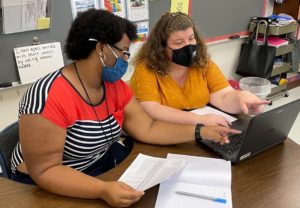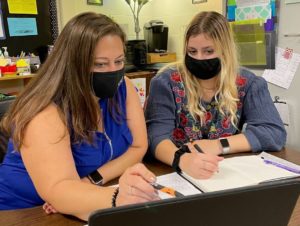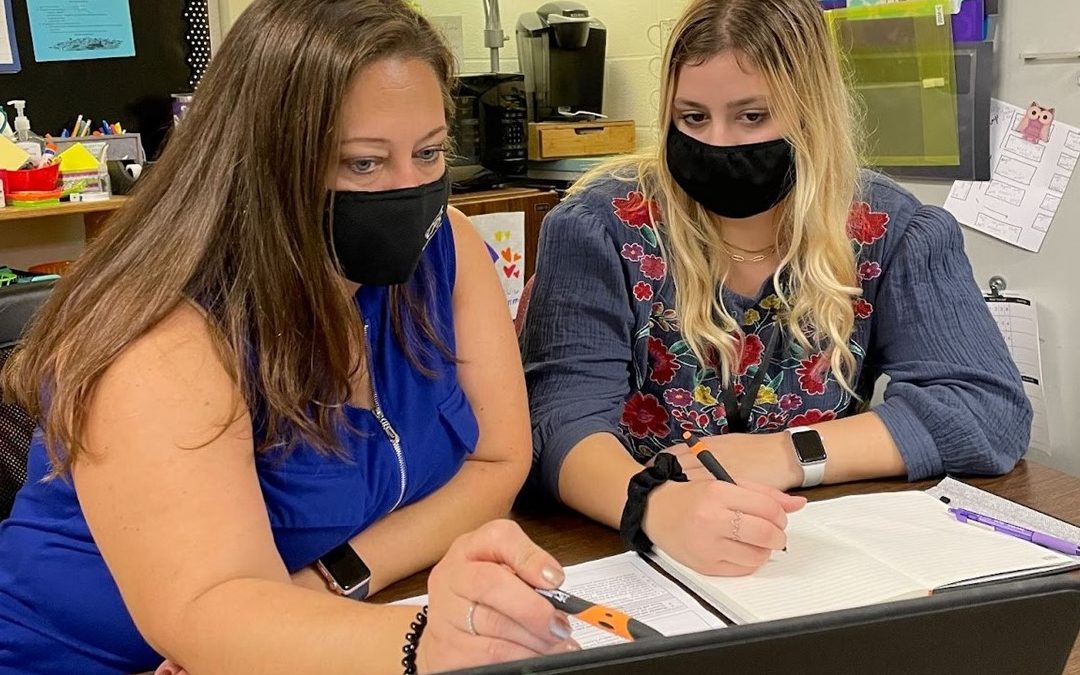Kristine M. Calo, Associate Professor/Early Childhood Education program coordinator, Hood College, calo@hood.edu
Tricia K. Strickland, Associate Professor/Elementary Education and Special Education program coordinator, Hood College, strickland@hood.edu
Jessica Wise, Third Grade Teacher/Team Leader, Monocacy Elementary School, Jessica.Wise@fcps.org
For the past two years, professors Tricia Strickland and Kristine Calo have worked with local schools to support teacher candidates as they provide specially designed instruction (SDI) to students with disabilities. Some educators mistakenly assume that only special education teacher candidates need to know this information. According to the National Center for Education Statistics (2021), 63.4% of students with disabilities are in general education classrooms at least 80% of the time. General educators teach students with disabilities and collaborate with special educators to adapt daily instruction so that students with disabilities can access and make progress in the general education curriculum and achieve their IEP goals (MSDE, 2019).
Toward that end, we surveyed educators in our local schools to identify what they believe our teacher candidates need to know, understand, and be able to do to provide SDI to PreK-grade 8 students with disabilities. We also conducted teacher and administrator focus groups. Using this data and research literature, we designed collaborative seminars for teacher candidates and mentor teachers. The seminar establishes a clear, collective understanding of what SDI is and is not. An initial card sort encourages discussion as teaching teams determine what constitutes SDI. Next, we unpack differences among SDI, Differentiation, and Universal Design for Learning both in theory and practice. Upon revisiting the card sort, an intern noted her team’s shift in understanding:
This learning was reflected when my group revisited the SDI-Maybe SDI-Not SDI chart. In the beginning of the seminar, we had put “Only for students who have IEPs” as Not SDI because we were thinking of it in terms of UDL or differentiation, however we changed this at the end because we now know that SDI is specific to a student who has a disability and their individual needs. I thought it was interesting that SDI is the definition of special education, as it really means adapting to meet the unique needs of a student.
Participants analyze an article and make connections to their own classrooms, focusing on frameworks and models highlighted in the text (Riccomini, Morano & Hughes, 2017). The seminar also delves into SDI in mathematics and ELA.
Opportunities for reflection, discussion, and collaborative planning are infused throughout. An intern noted, “The main aspect of the seminar that I appreciated, was the mentors’ and veteran teachers’ perspectives, information, and experiences that they brought to it. With every part of the seminar, there was a different mentor that had some type of experience that they were willing to share.” The seminar also benefits mentors. One shared,
I felt like there was a lot of learning taking place. I enjoyed the breakout rooms because I got to hear what the interns were thinking and doing in their placements and I also enjoyed being able to share my own experiences with the topics we were discussing.Mentors and teacher candidates collaboratively plan and deliver SDI in upcoming lessons using SDI planning and observation tools (MSDE, 2019), which support the design and delivery of high-quality SDI. 
Malana Stanley (teacher candidate) and Martha Moore (mentor) review a child’s IEP at MoES.

Jessica Wise (mentor) and Bri Sambuco (teacher candidate) plan SDI at Monocacy Elementary School (MoES).
References
Maryland State Department of Education (MSDE). (2019). A guide for implementing specially designed instruction within an integrated tiered system of supports.
National Center for Education Statistics. (2021). Percentage distribution of students 6 to 21 years old served under Individuals with Disabilities Education Act (IDEA), Part B, by educational environment and type of disability: Selected years, fall 1989 through fall 2019. https://nces.ed.gov/programs/digest/d20/tables/dt20_204.60.asp
Riccomini, P.J., Morano, S., & Hughes, C. A. (2017). Big ideas in special education: Specially designed instruction, high-leverage practices, explicit instruction, and intensive instruction. Teaching Exceptional Children, 50(1), 20-27.
